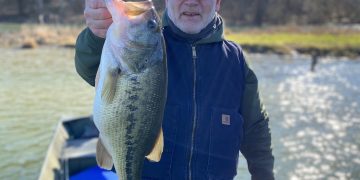I made my first butterfly collection when I was in the sixth grade while attending Timberville High School. My teacher, Margaret Hinkle thought it was wonderful. It soon fell by the wayside though. The Dermastid beetles ate the specimens up.
Being a habitual collector of everything, I started to collect or make a butterfly and moth collection. This was in 1969. I was told many stories of how my mother had a butterfly collection to go along with her other nature museum items that she housed in the “old house” that her father owned before she married my father in 1936. I still have a book of pressed wildflowers she put together. (Yes, the same house that she went to housekeeping in, in 1936, and where I was born). (See my book: “Hupp, Va. where I got my start”)
Ever since I started to work on my Butterfly and Moth collection in dead earnest there were a few species that I learned about that I should keep a vigilant eye out for. One of those was a moth in the family of Geometridae, one of the loopers or as you are probably used to, an inch worm. It happened to be Euchlaena milnei. Not common enough to have a common name. I also found out about The Lepidopterists Society which I joined, learning about things you do and things you don’t do in collecting.
Back then nothing was known about the life cycle, foodplant, etc. of this species. We also had no literature on moths and very little info on the butterfly species. The only thing we had was Hollands Moth Book and Hollands Butterfly Book. These books had very poor illustrations. The moth book does not mention E. milnei at all. They were first published in 1903.
Well would you believe, that day came in 1984. On the night of July 4, 1984 I was running my blacklights on a wooded ridge in the vicinity of Bergton, in the mountains west of Timberville and Broadway near the West Virginia line. As soon as it sat on my sheet I recognized it! After all I have been looking for this dude for 8 years. It’s a great feeling to find something this rare.
I managed to catch 2 specimens before I had to stop visiting this site due to the owner selling it to another party and the new owners didn’t want me messing around burning bright blue lights in the middle of the night. That was also a great location for other good species that I collected there. (A later article) At the time I did not have a vehicle with 4WD and in order to get up on this ridge/hill I had to take a running start to make it to the top. One year that I collected in this area I was out collecting somewhere every night from mid-March to November. I had a topper on my pickup which came in handy. One night at the Bergton location it started to rain, poured down. I crawled up under the topper and pulled the lights and generator in after me. It was a bit crowded I must say. The rain didn’t stop the moths from flying. I should have written a song “Collecting in the rain”. It could have been a hit.
Eventually I collected some of this same species at two other locations. My own property and at Caroline Furnace Lutheran Church Youth Camp in Page Co.
One of the two that were caught at Bergton was a female. I was able to get about a dozen eggs from her before she died. That is not many eggs when you consider that you know nothing about what type foodplant you had to find in a short amount of time for the tiny larvae to eat. When they don’t have anything to eat they die fast.
After trying several dozen different plants, shrubs that were found growing in the area, I noticed two of the larvae (I only had two left) were nibbling on this one shrub. So I threw everything else out and began feeding them the one they were nibbling on. Long story short, I got those two through to adult. They are pictured below. Upper left hand corner and bottom row, one on the right. There is another species that looks very similar.
Just recently, I notice where the life history of this species has Coffmannever been published. I guess I should have done it. Evidently I must be the only one to have reared it. But I was too busy collecting to be sitting around writing stories.
On one of my trips to the insect collection at the Smithsonian, I noticed they only had one ragged specimen. I knew this guy who had a book binding business and that had a contract of binding all the publications of the Smithsonian Museum. Once a month he would deliver the bound books and pickup more work to be done. He would let me ride along and got me introduced to the moth section of the museum. They let me rummage through their mass collection all day until time to come home.
When you got there on the main floor (the one with the huge elephant) I was to call the phone number they gave us and someone would show up to escort me up to the second floor where the collection was housed. Not everybody was eligible to go there. That was quite an experience to say the least.

































